FREE ACCESS INTERACTIVE AUDIOVISUAL MATERIAL TO SUPPORT VETERINARY CLINICAL PRACTICES
Abstract
In the Veterinary Hospital, clinical practices are developed in a real environment of many subjects of the Degree in Veterinary Medicine. The confluence of students from different educational levels generates a reality in which participation in clinical procedures that they have not yet studied can occur, as well as unlikely access to other less common procedures. The objective of the project was to generate clinical audiovisual material linked to free and open access bidi codes in the Veterinary Hospital consultations and to evaluate its teaching impact.
Audiovisual presentations with varying degrees of interactivity were produced, including clinical procedures, disease symptoms, and clinical cases using the Genially, LUMI, and Power-Point tools. Bidi codes were generated whose capture allowed direct free access to the material and were made available to students in general and to a group of 14 volunteers in particular. A utility, feasibility and interest study was carried out through ad hoc surveys (graded questions 1-10).
One hundred and fourteen surveys were collected, the analysis of which showed how the system used allowed quick (9.4/10) and technically simple (9.5/10) access to material that was generally considered to be of very good technical quality (8.9/10) and highly useful for teaching. (8.7/10). The materials made using Genially or Lumi had comparatively better average scores in the degree of interactivity than those for access to YouTube that only allow navigation but less interaction (8.75/10 vs 3.65/10). The Genially and Lumi materials also obtained better mean values in estimation of teaching utility (9.3/10 vs 7.8/10).
The generation of audiovisual material with quick and easy access, without the need to install applications or special programs, is highly useful and profitable for teaching. Materials that incorporate interactivity clearly provide added value that translates into better acceptance by the student and greater use in terms of learning.
Downloads
-
Abstract285
-
pdf (Español (España))209
References
Aguiar, B.O., Velázquez, R.M., Aguiar, J.L. (2019). Innovación docente y empleo de las TIC en la Educación Superior. Revista Espacios, 40 (2): 8.
Bergmann, J., Sams, A. (2012). “Flip Your Classroom: Reach Every Student in Every Class Every Day”, International Society for Technology in Education. Washington, DC.
Langebæk, R., Eika, B., Jensen, A.L., Tanggaard, L., Toft, N., Berendt, M. (2012). Anxiety in veterinary surgical students: a quantitative study. J Vet Med Educ, 39, 331-340, 10.3138/JVME.1111-111R1
Martinsen, S., Jukes N. (2005). Towards a humane veterinary education. J Vet Med Educ, 32, 454-460, 10.3138/jvme.32.4.454
Noyes, J.A., Carbonneau, K.J., Matthew S.M. (2022). Comparative Effectiveness of Training with Simulators Versus Traditional Instruction in Veterinary Education: Meta-Analysis and Systematic Review. J Vet Med Educ 49:1, 25-38, 10.3138/JVME-2020-0026.
Tvarijonaviciute, A., Carrillo-Sanchez, JD., Rubio, CP., Contreras-Aguilar, MD., Muñoz-Prieto, A., Pardo-Marin, L., Cerón, JJ., Franco-Martínez, L., Martínez-Subiela, S. (2022). Low-cost do-it-yourself (DIY) mannequin for blood collection: A comprehensive evaluation about its use in teaching. Res Vet Sci. 148:15-20. doi: 10.1016/j.rvsc.2022.04.009.
Vakilian, A., Ranjbar, EZ., Hassanipour, M., Ahmadinia, H., Hasani, H. (2022). The effectiveness of virtual interactive video in comparison with online classroom in the stroke topic of theoretical neurology in COVID-19 pandemic. J Educ Health Promot.l 29;11:219. doi: 10.4103/jehp.jehp_1297_21. PMID: 36177423; PMCID: PMC9514237.
Copyright (c) 2022 Servicio de Publicaciones, University of Murcia (Spain)

This work is licensed under a Creative Commons Attribution-NonCommercial-NoDerivatives 4.0 International License.
Creative Commons Attribution 4.0
The works published in this journal are subject to the following terms:
1. The Publications Service of the University of Murcia (the publisher) retains the property rights (copyright) of published works, and encourages and enables the reuse of the same under the license specified in paragraph 2.
© Servicio de Publicaciones, Universidad de Murcia, 2019
2. The works are published in the online edition of the journal under a Creative Commons Attribution-NonCommercial 4.0 (legal text). You can copy, use, distribute, transmit and publicly display, provided that: i) you cite the author and the original source of publication (journal, editorial and URL of the work), ii) are not used for commercial purposes, iii ) mentions the existence and specifications of this license.

This work is licensed under a Creative Commons Attribution-NonCommercial-NoDerivatives 4.0 International License.
3. Conditions of self-archiving. Is allowed and encouraged the authors to disseminate electronically pre-print versions (version before being evaluated and sent to the journal) and / or post-print (version reviewed and accepted for publication) of their works before publication, as it encourages its earliest circulation and diffusion and thus a possible increase in its citation and scope between the academic community. RoMEO Color: Green.




